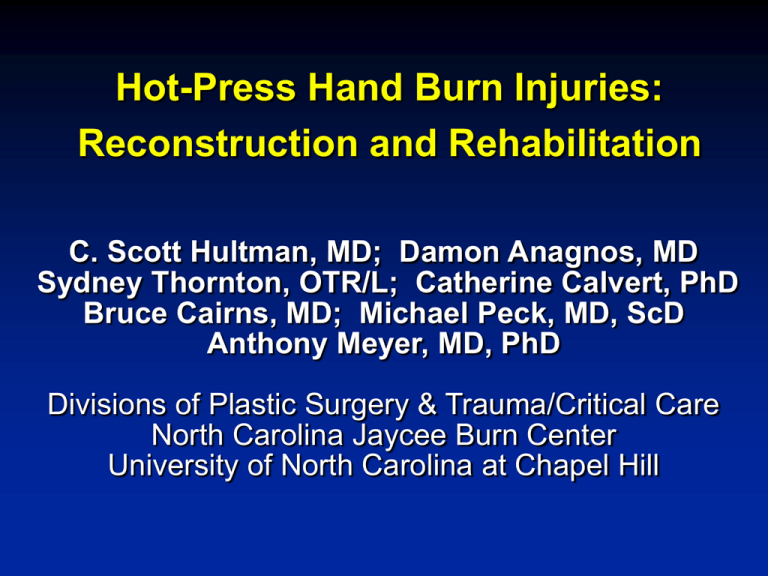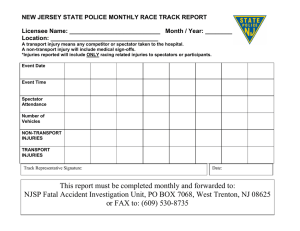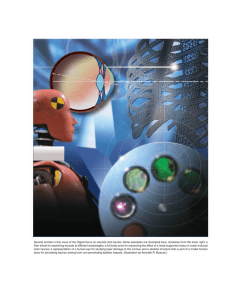Hot-Press Hand Burn Injuries: Reconstruction and Rehabilitation
advertisement

Hot-Press Hand Burn Injuries: Reconstruction and Rehabilitation C. Scott Hultman, MD; Damon Anagnos, MD Sydney Thornton, OTR/L; Catherine Calvert, PhD Bruce Cairns, MD; Michael Peck, MD, ScD Anthony Meyer, MD, PhD Divisions of Plastic Surgery & Trauma/Critical Care North Carolina Jaycee Burn Center University of North Carolina at Chapel Hill Introduction Hot-Press Hand Injuries • cause of significant hand trauma • crush/thermal component • wide range of morbidity • limited number of case reports • unknown long-term outcome Introduction Hot-Press Hand Injuries Hot-Press Hand Burn Treatment, Achauer et al, J Burn Care Rehabil 1998, 19;128-130 • n=17, 1994-1996 • non-op (41%), STSG (47%), flap (12%) • “normal hand function,” “good” cosmesis • one complication (minor graft loss) • no secondary reconstruction performed Purpose Hot-Press Hand Injuries • to assess our experience with hot-press hand burns • to determine which factors may influence functional recovery and return to work • to provide recommendations for management Methods Hot-Press Hand Injuries • December 1994 to April 2003 • retrospective analysis • n=33 • North Carolina Jaycee Burn Center • multi-disciplinary team of burn and plastic surgeons, hand therapists, clinical coordinators, social workers Methods Hot-Press Hand Injuries • burn center database electronic medical record chart review • pre-traumatic history operative management post-operative course long-term outcome Results Hot-Press Hand Injuries • mechanism: dry-cleaner (26), industrial press (5), home appliance (2) • mean age: 37.8 years • 28 female, 5 male patients • 17 admissions • mean length of stay: 11.4 days • mean follow-up: 17.3 months (range: 1-45) Hot-Press Hand Injuries Distribution of Cases by Year 10 8 patient 6 # 4 2 0 1 4 9 9 1 6 9 9 1 8 9 9 2 0 0 0 date of injury 2 2 0 0 Results Hot-Press Hand Injuries Acute Management mean surface area: 122cm2, dorsal >> volar operative management: 28/33 pts (85%) damage control: amputation (4), CRPP fracture (1) fasciotomy/CTR (2) staged excision: 14/28 pts (50%) acute coverage: STSG (17), FTSG (4), groin flap (6), adipofascial turnover flap (1) Results Hot-Press Hand Injuries Adverse Sequelae 18/33 pts (55%) chronic pain compressive neuropathy contracture (dorsal, volar, web) nail plate grooving deQuervain’s tenosynovitis skin graft loss boutonniere deformity mallet finger FDP tendon rupture 12 12 10 4 3 3 2 1 1 Results Hot-Press Hand Injuries Post-Traumatic Pain 12/33 pts (36%) deQuervain’s tenosynovitis 3 carpal tunnel syndrome cubital tunnel syndrome compression at Guyon’s canal chronic pain syndrome RSD 5 1 2 4 5 Results Hot-Press Hand Injuries Secondary Reconstruction 17/33 (52%) nerve decompression 11 CTR (4), digital (3), Guyon’s canal (2), cubital tunnel (1), ulnar dorsal sensory (1) nerve graft contracture release tendon reconstruction 1 10 6 tenolysis (3), tendon repair (2), transfer (1) joint reconstruction PIP capsulotomy (2), DIP arthrodesis (1) 3 Results Hot-Press Hand Injuries Secondary Coverage adjacent tissue rearrangement full-thickness skin graft pedicled flap 3 3 2 reverse dorsal metacarpal perforator flap reverse posterior interosseous flap free tissue transfer serratus lateral arm 2 Results Hot-Press Hand Injuries Neuro-Psychiatric “Continuum” nerve compression syndrome reflex sympathetic dystrophy chronic pain syndrome seizure disorder post-traumatic stress disorder depression and/or anxiety 12 5 4 2 5 33 Results Hot-Press Hand Injuries • few patients with normal range of motion • all patients compliant with occupational therapy • return to employment full-time restricted/modified functionally cleared failure to resume work malingerers 4 (12%) 5 (15%) 3 (9%) 21 (64%) none Summary Hot-Press Hand Injuries • devastating injury • significant long-term morbidity • early and late complications • limited functional recovery • return to work may not occur Recommendations Hot-Press Hand Injuries • early excision +/- staged re-surfacing • thick sheet grafts vs thin pedicled flaps • pre-/post-operative hand therapy • aggressive psycho-social support • anticipate need for late reconstruction (nerve decompression, flap revision, contracture release)


